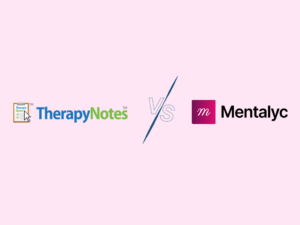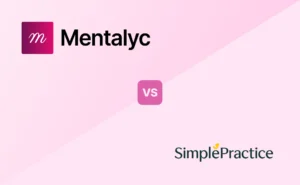As a mental health professional, providing accurate and detailed documentation of a client’s case history and present symptoms is crucial. By thoroughly and ethically reporting on impairments in functioning, you ensure your clients get the coverage and care they need.
But how do you accurately and ethically record the client’s impairments to make a case for their insurance to deem it a medically necessary treatment? As mental health professionals, we have to walk a fine line. We must provide enough details about the client’s challenges in critical areas without overstating or misrepresenting their conditions.
The key is documenting specific areas where your client’s mental health condition impacts their day-to-day life. Think work, school, relationships, self-care—the list goes on. If you’ve asked yourself any of these questions lately, you’ve come to the right place. This article explores strategies for documenting impairments ethically and effectively, not just for the well-being of your clients but also for insurance billing purposes and to ensure you’re appropriately reimbursed.
Client History: Presenting Problems and Symptoms
You must gather information about your client’s current symptoms and issues to start treatment. Look at their medical history to identify any conditions affecting their mental health. Be specific about their main issues, symptoms, and how they affect their daily lives. Ask open-ended questions about their concerns and reasons for seeking counseling. It’s imperative to be thorough.

New! Transfer your notes to EHR with a single click. No more copy-pasting.
Here are some areas to explore:
- Discuss their symptoms, including duration, frequency, and severity.
- Ask about past counseling, hospitalizations, medications, and treatment outcomes.
- Evaluate their functioning across life areas, such as work or school performance, relationships, and substance use.
Determining Medical Necessity
As a mental health professional, you must identify the medically necessary treatment for your client. This refers to treatment that is both reasonable and essential for diagnosing or addressing a mental health condition in compliance with accepted standards of care. Here are some factors to consider:
- How impaired is your client in crucial areas of life like work or school, self-care, and relationships? Severely impaired clients will likely require more intensive treatment.
- What treatments have already been attempted? Ongoing or long-term treatment may be necessary if previous interventions are ineffective or symptoms persist.
- What is your client’s diagnosis, and how debilitating is their condition? More severe or chronic diagnoses often require extended care.
- Are there any safety risks if treatment is not provided? This indicates a high need for medically necessary care.
- What do established practice guidelines recommend for your client’s condition?
Documenting Specific Examples and Behaviors
When documenting impairments, it is vital to be detailed yet concise. Provide specific examples and behaviors that show how the condition affects the client’s daily life, using their own words whenever possible. Assess the severity and frequency of symptoms, and note both strengths and challenges. By documenting these examples across different areas of their life, you can effectively communicate the extent of their impairment and emphasize the need for continued care.
- Note any difficulties with work or school responsibilities. For example, “Client has trouble concentrating at work due to racing thoughts, resulting in missing deadlines.”
- Report challenges in managing self-care or household tasks. For instance, “Client experiences periods of low motivation and energy where basic hygiene and chores are neglected.”
- Describe relationship issues that arise from their symptoms. For example, “Client has angry outbursts towards family members during episodes of mania.”
- Mention any health issues impacted by or related to their mental health condition. For example, “Client experiences insomnia and weight changes during cycles of depression.”
- Record problems with cognitive abilities like judgment, insight, or decision-making. For example, “Client exhibits poor impulse control and engages in risky behaviors without considering consequences.”
Functional Impairments: Difficulties with Work, School, and Self-Care
When recording your client’s functional impairments, provide specific details about the challenges they face in their daily life. It is critical to closely evaluate the extent of the impairment to determine the most suitable interventions. Determine if your client can continue to work or attend school with accommodations or if they require time off. Assess whether they can live independently or if they need extra support.
- Work/School: Note challenges like trouble concentrating, completing tasks, and interacting with colleagues or classmates. Mention any impact on performance or attendance.
- Self-Care: Highlight issues around personal hygiene, cooking, chores, and health management.
- Relationships: Discuss relationship strains, social withdrawal or conflicts, lack of intimacy, or emotional connection with loved ones.
Interpersonal Impairments: Relationship and Social Functioning
Relationships: When evaluating your client’s symptoms and impairments, it’s substantial to consider how they affect their social interactions and daily activities. You should engage with your client about their current status regarding close relationships, friendships, and participation in social events. You should engage with your client about their current status regarding close relationships, friendships, and participation in social events.
Here are some topics to consider:
- Can your client maintain long-term, meaningful relationships, or do they struggle with attachment, commitment, or intimacy?
- Does your client tend to isolate themselves or avoid social interaction and engagement? If so, how often and for what reasons?
- Can your client participate in social activities, connect with others, and engage in reciprocal conversations? Or do they tend to dominate interactions or struggle with communication, empathy, and social cues?
Family Dynamics: For many clients, family relationships significantly impact their well-being and functioning. Carefully document:
- How the client perceives family dynamics and closeness to immediate family members.
- Any recent life events like illness, death, divorce, or estrangement in the family and how the client copes.
- Are family members the source of stress, conflict, or a reliable support system?
- How family relationships may enable negative behaviors or unhealthy dynamics.
- Ways family therapy or counseling could benefit treatment.
Workplace or School: Interpersonal impairment can also extend into the workplace, classroom, or other social environments. It’s worthwhile to consider how cultural or family factors influence social functioning prior to documenting. Note any difficulties your client experiences:
- Establishing or sustaining relationships with colleagues, classmates, or peers.
- Managing conflicts, navigating workplace politics, or addressing performance issues.
- Completing group projects or participating in team-based activities.
- Handling authority figures like managers, professors, or administrators.
- Coping with job or academic stress healthy, constructively.
Health and Wellness Impairments: Sleep, Substance Use, Medical Issues
When documenting your client’s health and wellness, be thorough yet sensitive. Thoroughly assessing these areas will aid in developing an effective treatment plan to help improve their overall health, daily functioning, and quality of life.
Sleep: Lack of sleep can significantly impact your client’s health, mood, and daily functioning. Be sure to ask about their typical sleep schedule and duration. Note any issues falling or staying asleep, restless sleep, or daytime drowsiness. How often do they experience insomnia or hypersomnia? Do they use any substances to help them sleep? Document specific sleep impairments and their severity.
Substance Use: Alcohol, drugs, and excessive caffeine or nicotine can negatively impact your client’s health and daily life. Gently inquire about the types and amounts of substances they use, frequency of use, and if their usage causes problems. Note any desire to cut down without success. Specifically, document the types of substances used, patterns of use, and how use relates to their presenting issues or interferes with life tasks. Referral to medical care or support groups may be warranted.
Medical Issues: When communicating with your client, asking about any medical conditions or chronic illnesses that affect their daily life is important. Take note of any diagnoses, medications, or treatments, as well as any related impairments. Please refrain from giving medical advice. During the conversation, discuss pain, mobility, digestive problems, or changes in appetite or weight. If there are any urgent medical concerns or the client’s medical needs are not adequately addressed, referring them to a physician may be necessary.
Tips for Streamlining Impairment Documentation
As a healthcare provider, documenting impairments is critical to your job. However, balancing being comprehensive and efficient can also be time-consuming and challenging.
Here are some tips to help you streamline your documentation process:
Focus on the Most Important Information: While it’s important to be thorough in your documentation, not every detail must be included. Focus on the most significant impairments and how they impact the client’s daily life. Also, consider using bullet points or lists to make information more digestible.
Use Shorthand: Shorthand or abbreviations for commonly used phrases or terms can save you time. Ensure you use universally recognized abbreviations and clearly define them in your notes.
Be Concise: Avoid using overly complex language or unnecessary details. Stick to the facts and keep your documentation concise and to the point.
Keep your Notes up to Date: It’s essential to update your notes regularly to reflect changes in a client’s condition or treatment plan. This will help ensure you are providing the best possible care and can also help you avoid
Make the Most of Technology: Using technology to enhance your workflow and save time is a wise decision. Note-taking applications are revolutionary, allowing you to create progress notes swiftly, precisely, and securely. Mentalyc is an excellent choice because it complies with HIPAA and PIPEDA regulations and can instantly translate your therapy sessions into progress notes that meet insurance requirements. Register for a free trial today to see the benefits for yourself.
Common Questions About Documenting Client Impairments
A common question therapists have is how much detail to include when documenting a client’s impairments.
The short answer: be thorough but concise. Focus on specific examples and measurable outcomes.
How often should I assess and document impairments?
Continuously monitor your client for changes in functioning and impairment levels. Formally assess and document:
- At the intake, establish a baseline.
- Whenever there are significant changes reported or observed.
- At regular intervals, such as once a month or every other week.
What areas should I focus on?
Pay close attention to the following:
- Work or school performance: decreased productivity, difficulty concentrating, excessive absences.
- Self-care: changes in hygiene, sleep, appetite, exercise, health management.
- Daily life tasks: difficulty paying bills, cleaning, parenting, socializing.
- Relationships: increased conflict, withdrawal from others, codependency.
How detailed should I be?
- Briefly state the area of impairment, then give 1-2 specific examples to illustrate.
- Use quantifiable terms: “Client reports sleeping only 3-4 hours a night for the past week.” Rather than “Client reports difficulty sleeping.”
- Note the severity and frequency of impairments. For example, “Impaired concentration daily, impacting work productivity by about 50%.”
What if a client denies any impairments?
Gently explore further. Impairments are often hard to recognize or admit. Ask open-ended questions about daily routines, relationships, work, or school life. Observe for signs of impairment over multiple sessions. Note any discrepancies between client reports and your observations. Continually assess as therapy progresses, and the client’s insight may increase.
The key is providing an accurate snapshot of your client’s current level of functioning to determine medical necessity and progress. With practice, documenting impairments will become second nature, enabling you to paint a vivid and ethical picture of your client’s situation.
Be Specific
- Don’t just state that a client has problems with relationships or work. Give concrete examples of difficulties, e.g., frequently arguing with a spouse and trouble meeting deadlines due to avoidance.
- Cite observable behaviors and actual incidents to support your assessment. Saying a client “appears depressed” is not as helpful as noting things like crying during the session, lack of motivation or energy, difficulty sleeping, or changes in appetite.
Use Quantifiable Terms
- Note the frequency, intensity, and duration of symptoms and problems. Words like “often,” “periodic,” “chronic,” or “acute” can help accurately capture the client’s situation.
- Include specific time periods, if possible, e.g., trouble concentrating 3-4 days per week over the last month. This helps establish medical necessity and track progress.
Address Counterarguments
- Anticipate questions or challenges to your assessment and address them. For example, if a client maintains employment and relationships, explain any impairments in these areas, e.g., conflict with coworkers, lack of intimacy, or emotional connection in relationships.
- Explain the discrepancy between a client’s statements and your observations. The client may minimize or be unaware of the severity of their symptoms. Your role is to evaluate their functioning objectively based on all available information.
Maintain Objectivity
- Focus on observing and describing a client’s behaviors, thoughts, and feelings without judgment. Avoid personal opinions or reactions.
- Use quotes from the client and specific examples from your interactions with them to strengthen your objectivity. This also helps substantiate your analysis in case of questions or audits.
Finding the right balance between too much and too little detail is the key. Thorough, objective, and quantifiable impairments documentation is essential for effective treatment and ensuring medical necessity. With practice, documenting impairments will become second nature.
Properly documenting impairments is not only crucial for justifying treatment, but it also leads to providing the best care for your clients. By conducting a thorough assessment, asking detailed questions, and reporting objectively, you’ll be able to accurately capture the negative impact on their life and the severity of their condition. It’s important to be transparent, avoid speculation, and follow best practices for progress notes.
Remember, your notes have real consequences that can affect your client’s well-being, insurance coverage, and legal matters. With diligent reporting, you can have confidence in the integrity of your notes and be an effective advocate for your clients’ needs. So, take the time to assess, discuss, and document your clients’ impairments carefully. Your documentation could make all the difference in their progress and recovery. If you follow these best practices, you’ll be documenting impairments accurately and ethically in no time.
Disclaimer
All examples of mental health documentation are fictional and for informational purposes only.
Why other mental health professionals love Mentalyc

“A lot of my clients love the functionality where I can send them a summary of what we addressed during the session, and they find it very helpful and enlightening.”
Therapist

“By the end of the day, usually by the end of the session, I have my documentation done. I have a thorough, comprehensive note … It’s just saving me hours every week.”
CDCII

“It takes me less than 5 minutes to complete notes … it’s a huge time saver, a huge stress reliever.”
Licensed Marriage and Family Therapist

“It’s so quick and easy to do notes now … I used to stay late two hours to finish my notes. Now it’s a breeze.”
Licensed Professional Counselor






